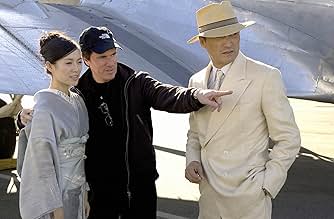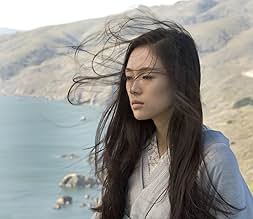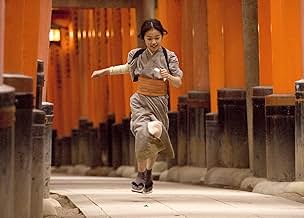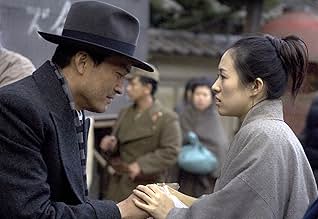Nitta Sayuri révèle comment elle a transcendé ses origines dans un village de pêche pour devenir l'une des geishas les plus célèbres du Japon.Nitta Sayuri révèle comment elle a transcendé ses origines dans un village de pêche pour devenir l'une des geishas les plus célèbres du Japon.Nitta Sayuri révèle comment elle a transcendé ses origines dans un village de pêche pour devenir l'une des geishas les plus célèbres du Japon.
- Réalisation
- Scénario
- Casting principal
- Récompensé par 3 Oscars
- 32 victoires et 47 nominations au total
Avis à la une
As someone who read the book before watching the movie, I was pleased with the adaptation. The right parts were highlighted and felt the cuts made were necessary for length. The story is truly a tragically beautiful one, and the actors cast fit their characters. Great acting and some beautiful cinematography. Sayuri's dance scene was mesmerizing.
Can a group of American men and Chinese actresses render the world of a Japanese geisha? The answer is yes, with stunning beauty
and regrettable flaws.
Truth be told, this movie was not as bad as its trailer led me to expect it to be. It had a story to tell (although it crumbles in the end),images to show, and material to present. There were ample displays of exquisite beauty -- the trailing tails of silk kimonos, the subtle allure of hand gestures, and the captivating scene of kabuki dance theater ...
On the other hand, the American director was not able to pull the Japanese out of Chinese actresses. (This movie was so crowded by famous Chinese idols that I found myself inadvertently searching for Joan Chen among the cast.) To be fair, all three main actors (Gong Li in particular) show strong performances that made me sympathetic to Rob Marshall's choices. However, they remain utterly Chinese throughout this movie. The look and accent are not the only problems. They lacked the kind of extreme femininity and excessive felicity of the delicately mechanical gesture and movements of traditional Japanese ladies you see in custom dramas of Japanese production. (Michelle Yeoh seems to be the only one trying a little bit of those, but it did not quite work for some reason.)
So, let me re-address the question: Can a group of American men and Chinese actresses render the world of a geisha? The answer, I guess, really depends on what you are looking for. If you would like a little bit of delight from an aesthetically pleasing picture with a dubious authenticity and realism, this movie delivers it. I would not say Rob Marshall failed completely. Memoirs of a Geisha is not the first, nor the last, movie that subjects another culture to the crude lens of American exoticism. It definitely is not the worst one.
Truth be told, this movie was not as bad as its trailer led me to expect it to be. It had a story to tell (although it crumbles in the end),images to show, and material to present. There were ample displays of exquisite beauty -- the trailing tails of silk kimonos, the subtle allure of hand gestures, and the captivating scene of kabuki dance theater ...
On the other hand, the American director was not able to pull the Japanese out of Chinese actresses. (This movie was so crowded by famous Chinese idols that I found myself inadvertently searching for Joan Chen among the cast.) To be fair, all three main actors (Gong Li in particular) show strong performances that made me sympathetic to Rob Marshall's choices. However, they remain utterly Chinese throughout this movie. The look and accent are not the only problems. They lacked the kind of extreme femininity and excessive felicity of the delicately mechanical gesture and movements of traditional Japanese ladies you see in custom dramas of Japanese production. (Michelle Yeoh seems to be the only one trying a little bit of those, but it did not quite work for some reason.)
So, let me re-address the question: Can a group of American men and Chinese actresses render the world of a geisha? The answer, I guess, really depends on what you are looking for. If you would like a little bit of delight from an aesthetically pleasing picture with a dubious authenticity and realism, this movie delivers it. I would not say Rob Marshall failed completely. Memoirs of a Geisha is not the first, nor the last, movie that subjects another culture to the crude lens of American exoticism. It definitely is not the worst one.
Going into the film, I had worries with all the slamming critics have given, even though I didn't read all of them in details. However, I'm happy to say it turns out to be one of more satisfying movie experiences of the year.
First I echo the sentiment that the film is simply technically perfect. The retro-mood it created had me immensed in the world of geisha from beginning to the end. It's very 1930 Shanghai like. The music score isn't as haunting as the one in CTHD, but it is still masterfully composed and fits in the background very well. It's worth seeing for the big screen experience alone. The story also never dragged, as each of the three parts flowed nicely. I normally don't like voice-over, but here it really held the movie together and helped to move the story along.
As for the accents, the problem has definitely been exaggerated. I was expecting a lot of unpleasant broken English to be spoken, but they all sounded fine to good, not just from the most fluent Michelle Yeoh, but Ken Watanabe, Youki Kudoh (who plays Pumpkin) and other supporting casts. Gong Li had a few awkward lines at the beginning, and Ziyi had more and is the one who had to try the hardest, but both pulled off admirably and didn't hurt their performances in the process.
Talking about performances, I think almost all of them did well. It's much more of an ensemble piece, and I was especially impressed by the young Sayuri and Ken Watanabe.
The main problem I have is with character development. It is a Cinderella story at heart, but the good and evil are too clear-cut and lack dimension. I also want to see more ups and downs for the competition between Ziyi and Gong Li. Gong did all she could, but the script didn't allow her to be a worthy opponent. Except for some verbal back-and-forth between the two and a few dirty tricks from Gong, there was no reason to believe why she was the most famous geisha in Japan before Ziyi arrived.
In addition, the Mother character is over-the-top and didn't fit the emotional aspect the film quite well, although she did provide some comical moments. The big dance scene had excellent buildup, but the execution of the dance felt flat. It lasted only about 30 seconds, while doubling that and making it more mesmerizing would have made the whole middle act more effective.
These flaws didn't overshadow the fact that what was put on screen worked for me. Will I be willing to watch it again with friends? In a heartbeat. Will I recommend it to others? Definitely. With that in mind, I give the film an A-.
First I echo the sentiment that the film is simply technically perfect. The retro-mood it created had me immensed in the world of geisha from beginning to the end. It's very 1930 Shanghai like. The music score isn't as haunting as the one in CTHD, but it is still masterfully composed and fits in the background very well. It's worth seeing for the big screen experience alone. The story also never dragged, as each of the three parts flowed nicely. I normally don't like voice-over, but here it really held the movie together and helped to move the story along.
As for the accents, the problem has definitely been exaggerated. I was expecting a lot of unpleasant broken English to be spoken, but they all sounded fine to good, not just from the most fluent Michelle Yeoh, but Ken Watanabe, Youki Kudoh (who plays Pumpkin) and other supporting casts. Gong Li had a few awkward lines at the beginning, and Ziyi had more and is the one who had to try the hardest, but both pulled off admirably and didn't hurt their performances in the process.
Talking about performances, I think almost all of them did well. It's much more of an ensemble piece, and I was especially impressed by the young Sayuri and Ken Watanabe.
The main problem I have is with character development. It is a Cinderella story at heart, but the good and evil are too clear-cut and lack dimension. I also want to see more ups and downs for the competition between Ziyi and Gong Li. Gong did all she could, but the script didn't allow her to be a worthy opponent. Except for some verbal back-and-forth between the two and a few dirty tricks from Gong, there was no reason to believe why she was the most famous geisha in Japan before Ziyi arrived.
In addition, the Mother character is over-the-top and didn't fit the emotional aspect the film quite well, although she did provide some comical moments. The big dance scene had excellent buildup, but the execution of the dance felt flat. It lasted only about 30 seconds, while doubling that and making it more mesmerizing would have made the whole middle act more effective.
These flaws didn't overshadow the fact that what was put on screen worked for me. Will I be willing to watch it again with friends? In a heartbeat. Will I recommend it to others? Definitely. With that in mind, I give the film an A-.
Lavish cinematography means 'Memoirs of a Geisha' is never anything less than visually beautiful, and it's hard to think of how any other movie could beat it to an Oscar in this department come March next year. However, the true merit of the film lies in the fact that its sumptuous style does not outweigh substance, something particularly thankful given that such an imbalance was so unfortunately true of House of Flying Daggers, the last major release to star Ziyi Zhang. Instead, the truly enchanting performance of 12-year old Suzaka Oghu, who plays the young Sayuri for the first half hour, ensures attention is captured within her character's story for the rest of the drama. This allows the script to remain pleasingly understated, and also means the unlikely nature of the romance can be overlooked.
The hibernation that the story withdraws into during the wartime years could so easily have been damaging, but in the event the portrayal of how the post-war influx of American troops corrupted Japan's ancient traditions is just as excellent as the rest of the film.
The hibernation that the story withdraws into during the wartime years could so easily have been damaging, but in the event the portrayal of how the post-war influx of American troops corrupted Japan's ancient traditions is just as excellent as the rest of the film.
I lived in Japan for 3 years and I loved the book, rich with visual imagery. I went to the see the movie with a good deal of trepidation, convinced that they were going to butcher it and sex it up to appeal to American audiences. Instead I sat spellbound in my seat as I watched the images that Arthur Golden has created in my mind with words years before, play themselves out on the screen in front of me. Every shot, ever scene, every tiny detail was just beautiful. I literally did not look away from the screen the entire time. The acting wasn't spectacular. I think they could have found somebody better to play Sayuri. The children were all wonderful. The stand-out actress by far was Gong Li as Hatsumomo. The villain had the best opportunities to show her skills as a thespian. The plot stuck very closely to the book. They eliminated the scenes that they needed to in the interest of time, but they didn't try to take any shortcuts or speed up the plot. I really felt like the story was played out beginning to end without sacrificing any of the meat. You'll read a lot of reviews in the coming weeks praising the gorgeous photography. Every word is true. Words like "lush" and "exquisite" only begin to do it justice. I've never had the experience of being transported to another time by a movie in quite this way.
Le saviez-vous
- AnecdotesThe elements of nature are a running theme through this film and each of the four main Geisha have an elemental character. Sayuri is water, Mameha is wind, Pumpkin is wood (the equivalent of earth) and Hatsumomo is fire.
- GaffesWhen Hatsumomo and Pumpkin are leaving on the night of Pumpkin's debut, neither Mother nor Auntie spark flint on their backs. A Geisha would never leave her okiya without this act being performed as it was believed it brought good luck.
- Crédits fousNo studio logos are shown at the beginning; they appear shortened after the end credits and are accompanied by the film's score.
- ConnexionsFeatured in The 63rd Annual Golden Globe Awards 2006 (2006)
- Bandes originalesAnata No Mono Yo
Written by Takao Saeki and Kôka Sassa
Performed by Noriko Awaya
Courtesy of Columbia Music Entertainment, Inc.
Meilleurs choix
Connectez-vous pour évaluer et suivre la liste de favoris afin de recevoir des recommandations personnalisées
Détails
- Date de sortie
- Pays d’origine
- Site officiel
- Langues
- Aussi connu sous le nom de
- Memorias de una geisha
- Lieux de tournage
- California State Railroad Museum - 111 I Street, Sacramento, Californie, États-Unis(interiors: railroad station)
- Sociétés de production
- Voir plus de crédits d'entreprise sur IMDbPro
Box-office
- Budget
- 85 000 000 $US (estimé)
- Montant brut aux États-Unis et au Canada
- 57 490 508 $US
- Week-end de sortie aux États-Unis et au Canada
- 682 504 $US
- 11 déc. 2005
- Montant brut mondial
- 162 242 962 $US
- Durée2 heures 25 minutes
- Couleur
- Mixage
- Rapport de forme
- 2.39 : 1
Contribuer à cette page
Suggérer une modification ou ajouter du contenu manquant








































